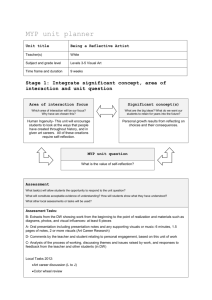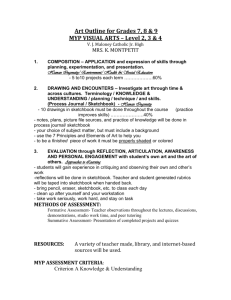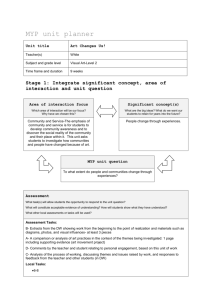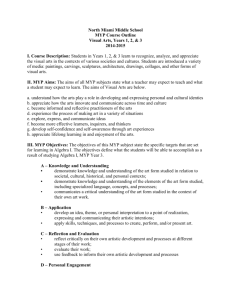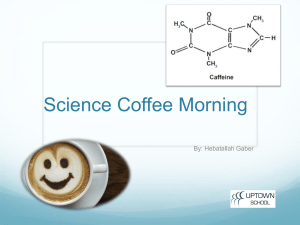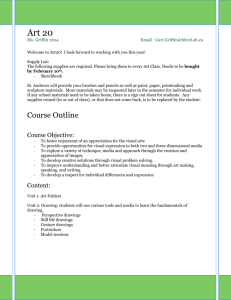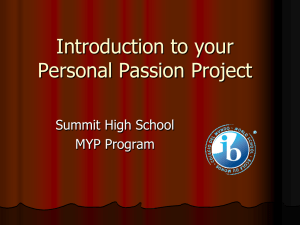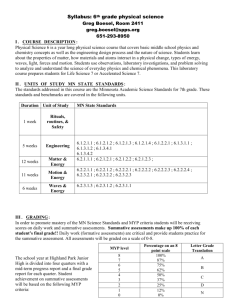MYP unit planner
advertisement
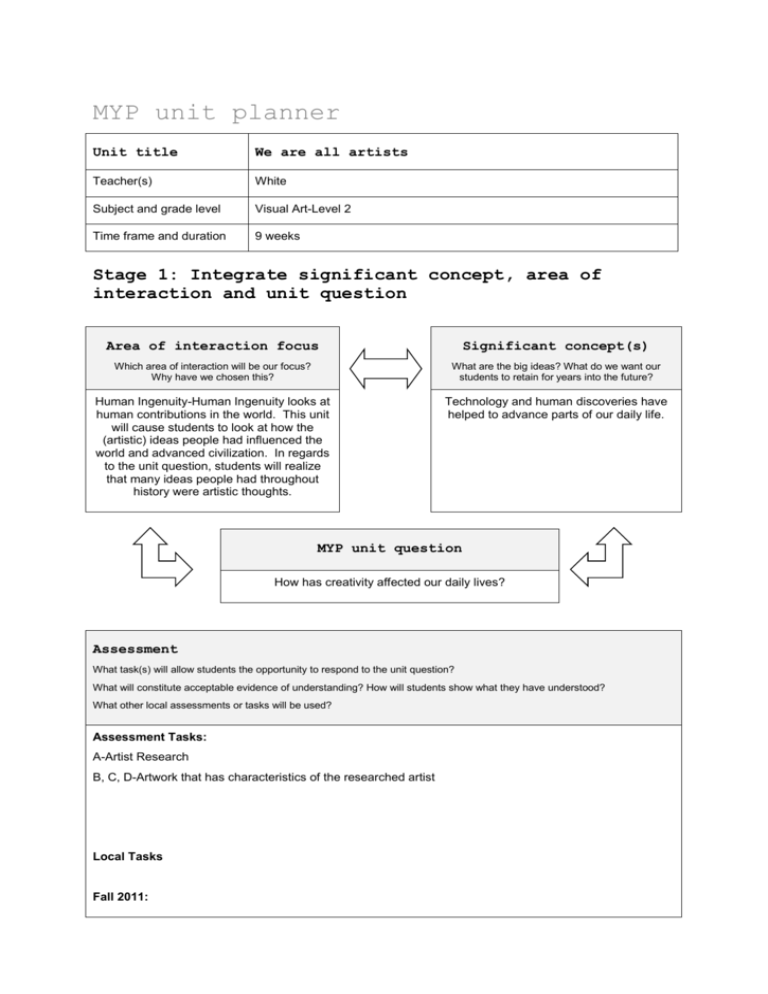
MYP unit planner Unit title We are all artists Teacher(s) White Subject and grade level Visual Art-Level 2 Time frame and duration 9 weeks Stage 1: Integrate significant concept, area of interaction and unit question Area of interaction focus Significant concept(s) Which area of interaction will be our focus? Why have we chosen this? What are the big ideas? What do we want our students to retain for years into the future? Human Ingenuity-Human Ingenuity looks at human contributions in the world. This unit will cause students to look at how the (artistic) ideas people had influenced the world and advanced civilization. In regards to the unit question, students will realize that many ideas people had throughout history were artistic thoughts. Technology and human discoveries have helped to advance parts of our daily life. MYP unit question How has creativity affected our daily lives? Assessment What task(s) will allow students the opportunity to respond to the unit question? What will constitute acceptable evidence of understanding? How will students show what they have understood? What other local assessments or tasks will be used? Assessment Tasks: A-Artist Research B, C, D-Artwork that has characteristics of the researched artist Local Tasks Fall 2011: Sketchbooks 1-4 Warmups weeks 1-8 Baseline Crossword to review elements and principles Bookmarks for binder Book project Quiz on elements and principles Weaving on sticks Artist Research (Rubric A) Artwork about that artist (Rubrics B-D) Presenting artist research and artwork Accordion foldable (notes during presentations) Text collage Printmaking with found objects Fall 2010: Sketchbooks 1-8 Warmups weeks 1-8 Quiz on elements and principles of art Pinwheel for peace (in conjunction with Level 3 unit) Gallery Walk Book Weaving Text collage Kanji symbol/Asian landscape project Which specific MYP objectives will be addressed during this unit? B-Develop an idea, theme or personal interpretation to a point of realization, expressing their artistic intentions Apply skills, techniques, and processes to create, perform and/or present art A-Demonstrate knowledge and understanding of the art form studied in relation to societal, cultural historical and personal contexts Demonstrate knowledge and understanding of the elements of the art form studied, including specialized language, concepts and processes Communicate a critical understanding of the art form studied in the context of their own artwork D-Show commitment in using their own artistic processes Demonstrate curiosity, self-motivation, initiative and a willingness to take informed risks Support, encourage and work with their peers in a positive way Be receptive to art practices and artworks from various cultures, including their own C-Reflect critically on their own artistic development and processes at different stages of their work Evaluate their work Use feedback to inform their own artistic development and processes Which MYP assessment criteria will be used? Criterion A,B,C and D Stage 2: Backward planning: from the assessment to the learning activities through inquiry Content What International Connections are being made throughout this unit? What knowledge and/or skills (from the course overview) are going to be used to enable the student to respond to the unit question? What (if any) state, provincial, district, or local standards/skills are to be addressed? How can they be unpacked to develop the significant concept(s) for stage 1? Fall 2011 Students will see, sketch, and discuss works of art from Africa through warm-ups Students will select, research, and analyze work by artists from around the world and will then emulate his or her style through the creation of an original work of art Fall 2010 Students will participate in Pinwheels for Peace project and will attend an “International Day of Peace” assembly at Northview on September 21, 2010, hosted by the arts department. Students will see examples of what woven products look like in different countries around the world, and will discuss differences and similarities between them Students answered questions about and discussed Day of the Dead through the use of warmup images and questions. Students discussed characteristics of African masks, after seeing an example on a warmup question. Students will make an international connection through doing weekly sketchbook assignments. Every week, students will also explain (through writing) how their sketchbook assignment shows something about another culture or country. Students participated in a Gallery Walk, which included viewing work by artists from around the world. 7.CR.1.1 7.CR.1.2 7.V.1.1 7.V.1.2 7.V.1.4 7.V.2.2 7.V.2.3 7.V.3.1 7.V.3.2 7.CX.1.1 7.CX.1.3 Approaches to learning How will this unit contribute to the overall development of subject-specific and general approaches to learning skills? Transfer-Students will transfer what they already have in their schema of everyday objects/culture to what they are learning about art being everywhere. Students will acknowledge parts of our everyday culture as “art.” Collaboration- Students will collaborate with each other to plan for and create art. Through this collaboration, art skills will be enhanced, and students will grow their ability to collaborate with all types of people. Learning experiences How will students know what is expected of them? Will they see examples, rubrics, templates? How will students acquire the knowledge and practise the skills required? How will they practise applying these? Do the students have enough prior knowledge? How will we know? Students will see examples, non-examples, checklists and rubrics for tasks. Students will acquire the knowledge based on demonstrations and hands-on experiences. Prior student knowledge will be assessed with warm-up questions. Further formative assessments will be conducted verbally and through observation, and will continue for the duration of the unit as new skills and concepts are introduced. Teaching strategies How will we use formative assessment to give students feedback during the unit? What different teaching methodologies will we employ? How are we differentiating teaching and learning for all? How have we made provision for those learning in a language other than their mother tongue? How have we considered those with special educational needs? Reading/Writing Integration: Students will do “Read Think Write Pair Share” with the Sumi-e article. Verbal and demonstrative formative assessments will be used to give students feedback during the unit. The teacher will give group and one-on-one demonstrations and will discuss how given examples are examples or non-examples of the desired product. The teacher will employ various teaching strategies, including: demonstrations, discussions, collaborative work and peer feedback in a group setting, and through a culminating chance for students to present products to the class. Instruction will be differentiated as needed during every class period. Further examples, demonstrations, and reminders will be given to individual students and to the class. With these additional supports in place, all students will learn the concepts of the unit. For those learning in a language other than their mother tongue, handouts will be given in the appropriate language. Students with special educational needs will receive differentiated instructions for tasks and additional scaffolding as needed. Resources What resources are available to us? How will our classroom environment, local environment and/or the community be used to facilitate students’ experiences during the unit? NC Standard Course of Study The internet for art examples Computers with word processing The knowledge, expertise and experiences of others in the classroom Ongoing reflections and evaluation In keeping an ongoing record, consider the following questions. There are further stimulus questions at the end of the “Planning for teaching and learning” section of MYP: From principles into practice. Students and teachers What did we find compelling? Were our disciplinary knowledge/skills challenged in any way? Compelling-the use of non-traditional materials to weave with- even toothbrushes and Christmas stockings! Skills that were challenged-thinking of non-traditional materials that could be used in the book-making process What inquiries arose during the learning? What, if any, extension activities arose? Inquiries-What CAN”T be used to create art? Extension activities- A student requested having an art club, which will start meeting in October of 2010 How did we reflect—both on the unit and on our own learning? Reflection happened intermittently throughout warmup questions and conversations resulting from those questions. Students also reflected weekly when they filled out sketchbook rubrics. Students reflected on their own learning at the end of the unit when they assessed themselves and when they filled out the Unit Reflection sheet. Students also filled out some comments about learning on the “Plus/Delta/Next Steps” paper in the art room. Which attributes of the learner profile were encouraged through this unit? What opportunities were there for student-initiated action? Based on feedback on the student reflection sheets, all of the learner profile traits were encouraged throughout this unit. Opportunities for student-initiated action were prevalent throughout the unit. Students sit in collaborative table groups and give each other feedback on sketchbook assignments. Possible connections How successful was the collaboration with other teachers within my subject group and from other subject groups? What interdisciplinary understandings were or could be forged through collaboration with other subjects? I would like to work next time with Language A or B teachers so that students can translate their book project into another language authentically, not by using an online translator. Assessment Were students able to demonstrate their learning? Yes! Through sketchbook assignments, in class assignments, and discussions and conversations. How did the assessment tasks allow students to demonstrate the learning objectives identified for this unit? How did I make sure students were invited to achieve at all levels of the criteria descriptors? Criterion A- Students had a quiz on the elements and principles of art near the beginning of the semester, after reviewing the terms and incorporating them into the book that each student make. The image that students wrote about for Assessment Task A (weaving), they also participated in prior to that writing activity. Criterion B- Students had opportunities to choose their own artistic medium for every weekly sketchbook assignment. Students were shown weaving techniques and were successful with those techniques. Criterion C-I gave students weekly opportunities to give and get feedback on sketchbook assignments. Criterion D- Students had multiple opportunities to be engaged in the art-making process. Students were exposed to examples of weaving around the world. Are we prepared for the next stage? Yes Data collection How did we decide on the data to collect? Was it useful? Data was collected via warmup questions and discussions and through student reflections on assignment rubrics. Data was also collected from the elements and principles quiz. Yes, it was helpful to know what students already knew and what they were struggling with. Figure 12 MYP unit planner
